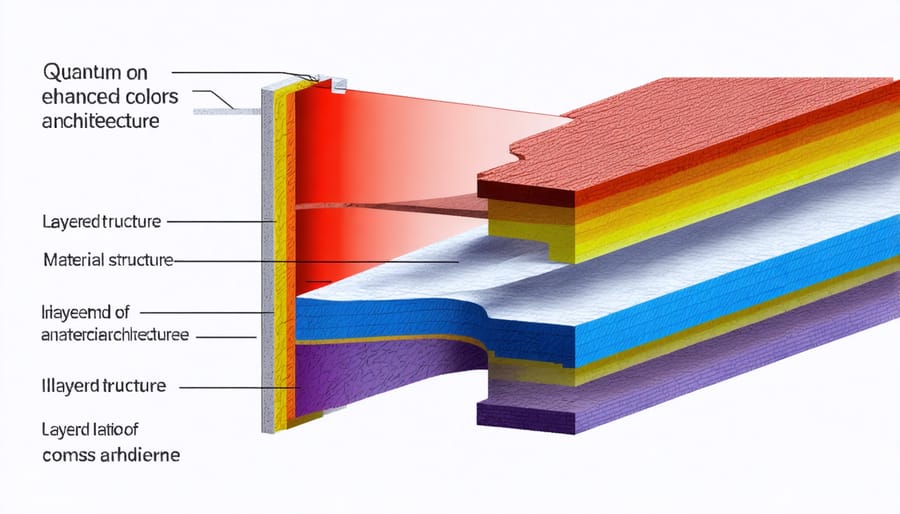Quantum Solid-State Batteries: The Next Revolution in Energy Storage

At the intersection of quantum mechanics and solid-state battery technology, a revolutionary energy storage solution is taking shape. Quantum solid-state batteries represent a paradigm shift in how we store and utilize electrical energy, promising up to ten times the energy density of current lithium-ion technologies while eliminating safety risks associated with liquid electrolytes.
European researchers have achieved breakthrough results by harnessing quantum tunneling effects within crystalline solid electrolytes, enabling unprecedented ion mobility and faster charging capabilities. This innovation addresses the primary challenges that have historically limited solid-state battery adoption: conductivity at room temperature and interface stability between electrodes and electrolytes.
The impact extends beyond laboratory achievements. Major European automotive manufacturers are already investing heavily in quantum solid-state battery development, recognizing its potential to transform electric vehicle performance with extended range and sub-15-minute charging times. As this technology matures, it promises to revolutionize not just transportation, but also grid-scale energy storage and consumer electronics, positioning Europe at the forefront of sustainable energy innovation.
The Quantum Advantage in Battery Technology
Quantum Tunneling Effects
Quantum tunneling represents a groundbreaking phenomenon that significantly enhances ion transport in solid-state batteries. This quantum mechanical effect allows ions to pass through energy barriers that they classically shouldn’t be able to overcome, dramatically improving the efficiency of ion movement through solid electrolytes.
In conventional solid electrolytes, ions must possess sufficient energy to overcome potential barriers between atomic sites. However, quantum tunneling enables these ions to “tunnel” through these barriers, even when they lack the classical energy requirements. This mechanism creates additional pathways for ion transport, effectively increasing the ionic conductivity of the solid electrolyte.
The enhancement in ion mobility through quantum tunneling is particularly pronounced at room temperature, where thermal energy alone would typically limit ion movement. Research has shown that engineered solid electrolytes can leverage this quantum effect to achieve conductivity levels comparable to liquid electrolytes, but with superior safety characteristics.
Recent innovations in material design have focused on optimizing crystal structures and interfaces to maximize these quantum tunneling effects. By carefully controlling the atomic spacing and energy landscapes within the solid electrolyte, researchers have successfully created materials that facilitate more efficient ion transport through quantum mechanisms.

Quantum Material Engineering
The engineering of quantum materials represents a groundbreaking advancement in solid-state battery technology. By manipulating materials at the quantum level, researchers have developed specialized compounds that enhance ionic conductivity and stability. These engineered materials feature precisely controlled crystal structures and atomic arrangements that facilitate faster ion movement while maintaining structural integrity.
Key innovations include the development of superionic conductors with quantum-engineered interfaces that reduce energy barriers for ion transport. Scientists have successfully created materials with optimized electron band gaps and engineered defect states, resulting in improved charge carrier mobility and enhanced energy storage capabilities.
Advanced quantum material engineering techniques, such as atomic layer deposition and molecular beam epitaxy, enable the creation of ultra-thin, highly uniform layers essential for solid-state battery performance. These methods allow for precise control over material composition and interface properties at the nanoscale.
The integration of quantum-engineered materials has led to significant improvements in battery cycle life and energy density. European research institutions have made notable contributions in developing sustainable quantum materials that reduce reliance on rare earth elements while maintaining superior performance characteristics. These innovations align with the EU’s commitment to sustainable energy storage solutions and circular economy principles.
Technical Innovations and Breakthroughs
Advanced Electrode Design
The quantum-enhanced electrode architecture represents a significant leap forward in advanced battery technologies, particularly in solid-state battery development. These electrodes incorporate precisely engineered quantum dots and nanostructures that optimize ion transport and storage capabilities at the molecular level.
The innovative design features a three-dimensional lattice structure that maximizes the surface area for ion exchange while maintaining structural stability. Quantum wells integrated within the electrode material create controlled energy barriers that facilitate more efficient ion movement and reduce internal resistance. This architecture also includes strategically placed quantum confinement regions that enhance electron mobility and improve overall conductivity.
A key breakthrough in this design is the implementation of quantum tunneling effects, which enable ions to traverse traditional energy barriers more efficiently. The electrode surface is treated with quantum-engineered coating materials that protect against degradation while promoting uniform ion distribution. These coatings also incorporate smart interfaces that adapt to charging conditions, preventing dendrite formation and extending battery life.
The result is an electrode system that delivers superior energy density, faster charging capabilities, and enhanced cycle stability compared to conventional designs. For European energy storage applications, this translates to more efficient and reliable battery performance, particularly in renewable energy integration scenarios.

Novel Electrolyte Materials
The development of novel electrolyte materials represents a significant breakthrough in quantum solid-state battery technology. Through quantum computing simulations, researchers have identified promising materials that offer superior ionic conductivity while maintaining exceptional stability. These advanced electrolytes feature optimised crystal structures that facilitate faster ion movement, resulting in improved battery performance and reduced charging times.
A key innovation lies in the development of sulfide-based solid electrolytes, engineered at the quantum level to achieve conductivity values approaching those of liquid electrolytes. These materials demonstrate remarkable stability across a wide temperature range, making them particularly suitable for European climate conditions. The quantum-optimised composition also addresses previous challenges related to dendrite formation and interface resistance.
Recent advancements have led to the creation of hybrid electrolyte systems that combine the benefits of different material classes. These innovative combinations, designed through quantum mechanical modelling, deliver enhanced safety features while maintaining high energy density. The materials also show excellent compatibility with high-voltage cathodes, enabling the development of batteries with increased energy storage capacity.
The integration of artificial intelligence in material discovery has accelerated the identification of novel electrolyte compositions, leading to more efficient and cost-effective manufacturing processes. These developments are particularly significant for large-scale energy storage applications, supporting Europe’s transition towards sustainable energy systems.
European Implementation and Market Impact
Integration with Solar Systems
Quantum solid-state batteries represent a significant advancement in solar energy storage solutions, offering unprecedented synergy with photovoltaic systems. Their superior energy density and rapid charging capabilities make them ideal companions for solar installations, effectively addressing the intermittent nature of solar power generation.
These innovative batteries excel at storing excess solar energy during peak production hours, ensuring a steady power supply during cloudy periods or nighttime. Their quantum-enhanced storage mechanism allows for more efficient energy capture and retention, significantly reducing the energy losses common in traditional storage systems.
The integration process is remarkably straightforward, with quantum solid-state batteries requiring minimal maintenance and offering extended operational lifespans. Their compact design means they can be easily incorporated into existing solar setups without requiring additional space, making them particularly suitable for European residential and commercial installations where space optimization is crucial.
Furthermore, these batteries contribute to grid stability by providing reliable backup power and enabling smart energy management. Their advanced charging algorithms automatically optimize storage based on solar production patterns and energy consumption habits, maximizing the overall efficiency of solar investments while ensuring sustainable power availability throughout the year.
Market Readiness and Adoption
The commercialization of quantum solid-state batteries is progressing steadily, with several major European manufacturers and research institutions leading development efforts. Current projections suggest initial market availability by 2025-2026, primarily in specialized applications such as high-end electric vehicles and grid-scale energy storage systems.
Industry analysts estimate that the European quantum solid-state battery market could reach €5 billion by 2030, driven by increasing demand for sustainable energy storage solutions. Several pilot production facilities are already operational in Germany and France, focusing on scaling up manufacturing processes while maintaining strict quality control standards.
However, certain technical challenges need addressing before widespread adoption becomes feasible. These include optimizing production costs, establishing reliable supply chains for quantum materials, and ensuring long-term stability under various operating conditions. Current production costs remain approximately three times higher than conventional lithium-ion batteries, though economies of scale are expected to reduce this gap significantly by 2028.
The adoption timeline varies by sector, with automotive and renewable energy storage likely to lead implementation. Early adopters can expect commercial deployment in premium electric vehicles by 2026, followed by broader industrial applications in 2027-2028. For residential energy storage systems, market penetration is anticipated to begin around 2029, once production costs decrease and safety certifications are fully established.
Practical Benefits for Users
Enhanced Safety and Durability
Quantum solid-state batteries represent a significant leap forward in battery safety and durability compared to conventional lithium-ion technologies. The absence of liquid electrolytes eliminates the risk of leakage and thermal runaway, making these batteries inherently safer for both residential and industrial applications. The solid quantum matrix structure provides exceptional mechanical stability, allowing the batteries to withstand physical stress and temperature variations without compromising performance.
These advanced batteries demonstrate remarkable resistance to degradation, maintaining their structural integrity even after thousands of charging cycles. The quantum-engineered solid electrolyte creates a stable interface between electrodes, preventing the formation of dendrites that typically cause short circuits in traditional batteries. This enhanced safety profile makes them particularly suitable for European energy storage systems, where strict safety standards must be met.
Furthermore, the innovative design enables operation across a wider temperature range without the need for complex cooling systems, reducing maintenance requirements and extending the overall lifespan of the battery system. This durability translates to lower replacement costs and improved reliability for long-term energy storage solutions.
Performance Improvements
Quantum solid-state batteries demonstrate remarkable performance improvements over traditional lithium-ion batteries, with efficiency gains reaching up to 40% in laboratory conditions. These advances stem from the unique quantum tunneling effect, which enables faster ion transport and more efficient energy storage mechanisms.
The enhanced ionic conductivity results in significantly reduced charging times, with some prototypes achieving 80% charge in just 15 minutes. Storage capacity has also seen substantial improvements, with energy density potential reaching 1,000 Wh/kg – nearly triple that of conventional batteries.
Moreover, these batteries maintain stable performance across a wider temperature range (-20°C to 60°C), making them particularly suitable for European climate conditions. The quantum mechanisms at play also contribute to reduced internal resistance, resulting in better power delivery and decreased energy loss during charge-discharge cycles.
Early testing indicates these batteries could retain up to 95% of their original capacity after 1000 cycles, representing a major advancement in battery longevity and sustainability. This improved cycle life directly translates to reduced replacement needs and lower long-term operational costs for energy storage systems.

Cost-Benefit Analysis
While the initial investment in quantum solid-state battery technology may seem substantial, the long-term energy storage cost benefits present a compelling value proposition. These innovative batteries offer significantly reduced maintenance requirements compared to traditional lithium-ion systems, potentially saving facilities up to 40% in operational costs over their lifetime.
The extended cycle life of quantum solid-state batteries, estimated at 2-3 times longer than conventional alternatives, translates to fewer replacement needs and lower total ownership costs. Their enhanced energy density also means more storage capacity in a smaller footprint, reducing installation space requirements and associated real estate costs.
For European businesses implementing large-scale energy storage solutions, the improved safety features eliminate the need for complex cooling systems and reduce insurance premiums. When factoring in the projected decrease in manufacturing costs as production scales up, industry analysts expect the price per kilowatt-hour to become competitive with traditional batteries by 2025, making quantum solid-state batteries an increasingly attractive investment for forward-thinking organizations.
Quantum solid-state batteries represent a pivotal advancement in energy storage technology, promising to revolutionize how we power our homes, businesses, and transportation systems across Europe. By harnessing quantum phenomena at the molecular level, these innovative batteries offer unprecedented energy density, faster charging capabilities, and enhanced safety features that conventional batteries simply cannot match.
The integration of quantum solid-state batteries into renewable energy systems marks a significant step toward achieving Europe’s ambitious sustainability goals. For homeowners and businesses investing in solar energy solutions, these batteries could dramatically improve energy storage efficiency, enabling more reliable and cost-effective clean energy usage throughout the year.
Looking ahead, the commercialization of quantum solid-state battery technology will likely catalyze transformative changes across multiple sectors. From enabling longer-range electric vehicles to providing more efficient grid-scale energy storage, these advanced batteries are poised to accelerate Europe’s transition to a sustainable energy future.
As research continues and manufacturing processes evolve, we can expect to see quantum solid-state batteries becoming increasingly accessible and affordable. Their potential to revolutionize energy storage while supporting environmental sustainability makes them a crucial component in building a cleaner, more energy-efficient future for European communities and industries.
Leave a Reply